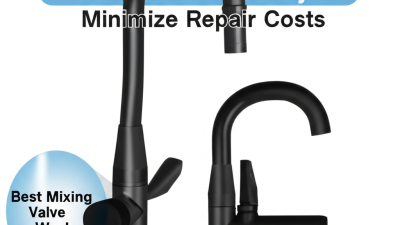In the realm of personal hygiene, the significance of using an effective Mixing Valve For Feminine Wash cannot be overstated. According to recent industry reports, the global feminine hygiene market is projected to reach $48 billion by 2025, highlighting the increasing awareness of women's health and hygiene. As consumers prioritize not only efficacy but also safety in their personal care products, the design and functionality of mixing valves have become crucial for ensuring optimal temperature control and preventing potential skin irritations. A high-quality mixing valve can enhance user experience while reducing overall maintenance and repair costs for manufacturers. By implementing a checklist-based approach when selecting these valves, businesses can maximize operational efficiency and minimize long-term expenditure, ultimately contributing to a more sustainable and responsible feminine hygiene market.

In feminine wash applications, the role of mixing valves is crucial for ensuring both efficiency and safety. Mixing valves regulate the temperature and flow of water, providing a gentle yet effective rinse that is essential for personal hygiene. Utilizing the right mixing valve not only enhances user comfort but also minimizes the risk of irritation or injury, particularly in sensitive applications like feminine washes. When selecting a mixing valve, it's vital to consider factors such as temperature control, durability, and ease of maintenance to ensure optimal performance.
Moreover, integrating high-quality mixing valves can lead to significant cost savings over time. By efficiently regulating water temperature and flow, these valves help prevent excessive energy use and water waste, contributing to lower utility bills. Additionally, choosing valves that are designed for easy repairs and replacements can further reduce maintenance costs and downtime. Overall, understanding the importance of mixing valves in feminine wash applications is essential for maximizing efficiency and minimizing potential repair costs, ultimately leading to better service and satisfaction.
When it comes to selecting the best mixing valve for feminine wash applications, key technical specifications play a crucial role in maximizing efficiency and minimizing repair costs. A report by the American Society of Plumbing Engineers indicates that mixing valves can reduce water consumption by up to 30% when they maintain optimal temperature control. Therefore, choosing a valve with accurate temperature regulation is paramount. Look for models that feature thermostatic control with a variance of no more than ±2°F to ensure the water delivered is consistently safe and effective.
In addition to temperature precision, flow rate is another critical specification. According to industry data, maintaining a flow rate of 2.5 gallons per minute (GPM) or higher is vital for ensuring proper rinsing capabilities. The ideal mixing valve should incorporate anti-scald technology, which not only enhances user safety but also increases the longevity of the valve itself. Reports suggest that mixing valves integrated with such technology can extend their service life by up to 50%, thereby significantly reducing maintenance and replacement costs. Investing in a high-quality mixing valve that adheres to these specifications will ensure efficient operation and cost-effective maintenance in feminine wash settings.
Installing a feminine wash mixing valve can seem daunting, but with the right approach, you can ensure a smooth and efficient installation process. Start by gathering all necessary tools and materials, including the mixing valve itself, adjustable wrenches, Teflon tape, and any additional fittings required for your specific setup. Before installation, it’s crucial to turn off the water supply to avoid any mishaps.
Next, carefully remove the old mixing valve if you have one and prepare the pipes for the new installation. Apply Teflon tape to the threads of your new valve to ensure a watertight seal. Follow the manufacturer’s instructions for connecting the valve, ensuring that the hot and cold water lines are matched correctly. Once everything is securely in place, turn the water supply back on and check for leaks. This step-by-step guide not only maximizes efficiency but also minimizes repair costs by establishing a reliable setup from the get-go.
| Feature | Description | Benefits | Installation Complexity | Average Cost |
|---|---|---|---|---|
| Thermostatic Control | Automatically regulates water temperature | Prevents scalding and enhances comfort | Moderate | $75 - $150 |
| Anti-Scale Technology | Reduces mineral buildup in the valve | Lengthens lifespan and minimizes repairs | Easy | $60 - $120 |
| Easy Clean Design | Smooth surfaces for hassle-free cleaning | Saves time and enhances hygiene | Easy | $50 - $100 |
| High Flow Rate | Delivers consistent water pressure | Enhances user experience during washing | Difficult | $80 - $200 |
Maintaining your mixing valve is crucial for optimizing its performance and prolonging its life. According to a study by the American Society of Plumbing Engineers, regular maintenance can reduce failure rates by up to 30%. This not only enhances safety and efficiency but also significantly cuts down repair costs, which can be upwards of $500 for a single valve replacement. By routinely checking for signs of wear, ensuring proper humidity regulation, and cleaning the valve, users can ensure their mixing valve remains in peak condition, providing a balanced flow of water temperature ideal for feminine wash applications.
Additionally, industry professionals recommend implementing a bi-annual inspection routine as part of your maintenance checklist. Ensuring that seals and gaskets are intact can prevent leaks, a common issue that escalates maintenance costs over time. A report from the Plumbing and Heating Contractors Association indicates that routine inspections could lead to a 25% savings in maintenance expenses, showcasing the importance of fostering a proactive approach. Simple actions like adjusting the mixing valve’s temperature settings according to usage can also enhance its efficiency and reduce operational costs in the long run. By prioritizing regular maintenance, users can enjoy not only a more efficient system but also a significant reduction in total repair expenses.
When it comes to maximizing efficiency and minimizing repair costs for mixing valves used in feminine wash applications, identifying common issues is crucial. A recent report by the American Society of Plumbing Engineers indicates that leaks in mixing valves can account for up to 30% of water wastage in residential settings, leading to increased utility bills and environmental concerns. Regular inspections and maintenance can help alleviate this issue, ensuring that the valves operate at optimal performance and reducing the likelihood of costly repairs.
Another common problem associated with mixing valves is improper temperature regulation. According to a study published by the International Journal of HVAC&R Research, nearly 25% of mixing valves fail to maintain the desired water temperature, leading to discomfort and potential health risks. Implementing advanced technologies such as thermostatic mixing valves can greatly improve temperature accuracy, thus enhancing user experience while also decreasing repair frequency. Investing in high-quality mixing valves not only addresses immediate issues but also provides long-term savings by preventing operational failures and extensive repairs.
